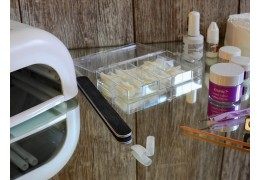Blog categories
Search in blog
Popular posts





Featured posts






You may have already experienced this scenario: the weather is warm and sunny, summer is coming and you are ready to wear your floral dresses. However, you suddenly realize that your legs are very pale. Fortunately, there is a solution that comes in the form of a tube filled with self-tanner, perfect for the pre-summer season. The use of self-tanner is known to give us a nice golden tan. However, its effects on the skin may raise concerns, especially regarding the potential harmfulness of the formula used to darken the skin and the possibility of waxing after applying the self-tanner. In this article, find our opinion on self-tanners and the answers to all the questions you may have.
DHA (dihydroxyacetone), an active ingredient found in self-tanners, has been debated because it reacts with amino acids in dead skin cells to darken the skin. The characteristic smell of self-tanners is also attributed to DHA. Most dermatologists, however, claim that using a self-tanner is safer than exposure to UV rays from the sun or tanning booths, which increase the risk of skin cancer. Many also dismiss speculation linking DHA to skin cancer, as no evidence has ever been found to support such claims.

When using self-tanning, it is important to pay attention to how and where you apply it. According to doctors, DHA, the main ingredient in self-tanners, is safe in the amounts used, but it is best to avoid the product coming into contact with the eyes or inhaling it. To stay safe, it is recommended that you apply self-tanner in a well-ventilated area and take measures to protect your eyes, nose and mouth.
When it comes to organic versus natural self-tanners, the only difference is in the source of DHA used — natural products for organic self-tanners (synthetic DHA) and synthetic products for non-organic self-tanners. Both types of self-tanners contain DHA that stays in the upper layers of the skin, and concerns about non-biological self-tanners penetrating beyond the skin and being harmful are unfounded. There is therefore no need to worry when choosing a self-tanner; organic or not, just choose the one you prefer.
Even if you use self-tanner to get the perfect tan, your skin will be affected by the sun in the same way as people who don't. It is therefore essential to protect your skin from the sun by using a sunscreen with at least SPF 50 for fair skin and SPF 30 for medium to dark skin. Although some self-tanners have an SPF, this only lasts two hours after application, hence the need to use adequate sun protection in addition.

If you plan to use self-tanner for an upcoming event, it is advisable to do a test beforehand. Dermatologists advise that self-tanning can give different results depending on skin type and can even cause allergic reactions. It is therefore recommended to carry out a test on a small part of the body at least 24 hours before applying the self-tanner to guarantee beauty and safety.
While pregnant women are advised to avoid many things, self-tanning is not one of them. Health professionals assure that DHA, a common ingredient in self-tanners, does not go beyond the top layer of the skin, which means it cannot harm the baby. However, pregnant women should be careful as their hormone levels can make their skin more susceptible to allergic reactions and degree of discoloration.
If you use self-tanner regularly, you probably know that it is essential to hydrate your skin to maintain a long-lasting tan. But what many don't know is that it's important to avoid moisturizers that contain oil. According to beauty and health experts, using moisturizers that are too oily can cause the DHA in self-tanner to break down and make the tan less radiant.

According to aesthetic doctors, applying a self-tanning product before laser hair removal can increase the risk of burning. This is because self-tanners darken the surface of the skin, making it more like hair color, which means the light from the laser will reach more of the skin instead of just the hair follicles. Therefore, hair removal may not be as effective and pose a high risk.
Dermatologists recommend monitoring your skin regularly to detect any changes in your moles or general appearance. It is recommended to self-check once a month and check every part of the body, including hard-to-see areas like the soles of the feet and the space between the toes. You have to take the time to observe your skin after showering or when applying self-tanner.
You now know our opinion on self-tanners. If these products do not present any danger to the skin in the majority of cases, it is however necessary to take care of certain specific situations. Also consider regularly exfoliating the skin to get rid of any dead skin cells that could prevent even application of a self-tanning product.